Lecture: God and Gutenberg (0 – 1450)

Moveable Type with Chinese Characters from Judy’s lecture
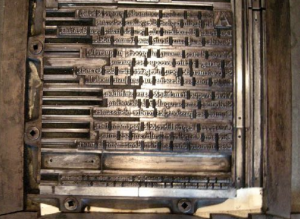
Moveable Type in German (discovered by Gutenberg) from Judy’s lecture
In this week’s Survey, we explored the invention of printing technique and new writing surfaces in mainly Europe and Asia.
Followed the late Before Common Era, we got to learn about the evolution in 0- 1450. We cover the topics on how European countries began to adapt from papyrus to parchment while eastern societies shifted from bamboo to paper. As we dive deeper into the topic, we realized that a lot of these inventions (like writing surface and printing techniques) were created under the basis of demands and adaptation. Because of this fundamental principle, there were often very similar inventions and development separately from different societies. An example would be the parallel of the east and west – the invention of metal moveable type by Johannes Gutenberg of Mainz from Germany and Bi Sheng from China. Though Bi Sheng came up with the idea 400 years before Gutenberg, moveable type was evidently more influential under the discovery by Gutenberg in 1440. From my own analysis, I believe that this phenomenon is mainly because of the fact that the Chinese characters consist of thousands of complex and distinct square-shaped symbols.
The invention of moveable type was intended to make printing technique more efficient. While printing press technique was convenient to use for an alphabet-based writing system like German (consisting of only 26 basic letters), it does not seem practical to have a whole tray with thousands of Chinese characters made for printing press. This also partially explains why the technique of moveable type invented by Bi Sheng did not spread widely across China.
Research: Rayonnant Gothic (1240 – 1350)
Followed by the success of advanced engineering techniques in construction during the High Gothic period, Raynonnant Gothic flourished under the basis of employing glamorous visual elements like stained window glass. So what’s the appeal of these stained glass windows and why is it still so prevalent in churches nowadays? Well, let’s dive a little deeper to explore the aesthetics of Rayonnant Gothic architecture!
Development in Style
To understand the concept of Rayonnant Gothic, we can trace back to the term “Rayonnant”, meaning “Radiant” in French that describes radiant lights reflected upon colorful stained glasses in Gothic cathedrals. One can immediately tell that the Rayonnant style in France heavily focused on the lavish ornaments. Decorations like stained window glass, gargoyles designed on two dimensional surfaces were often seen in this Gothic period.
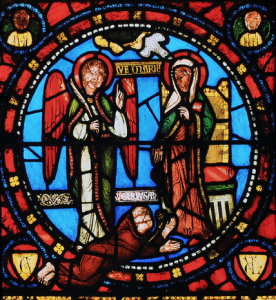
Abbot Suger
Abbey of Saint-Denis,
12th century
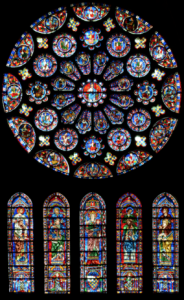
South transept rose window of Chartres Cathedral,
1221-1230
The signature style of Rayonnant Gothic was the use of stained glass on tracery. One of the earliest development in such change started with architect Hugues de Libergier in his treatment of Abbey Church of St. Nicaise in Reims. Along with plate-tracery (made with thinner stones and larger windows than the old-fashioned plate-tracery), Libergier integrated tracery and stained glass windows as both structural and decorative elements of the cathedrals. Some famous examples of stained glass windows in Gothic period were South transept rose window of Chartres Cathedral and Abbey of Saint-Denis. Most of the illuminations in these churches depict biblical stories (Christ and Mary), flowers and occasionally professionals who funded the cathedrals (drapers, stonemasons or the barrel-makers). The window tracery also consist of repetitive patterns and motif with mainly red and green stained windows.
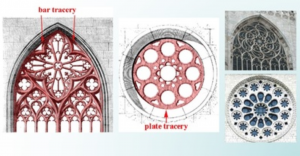
Plate Tracery vs Bar Tracery
Appearance
From architectural construction to the visual content and aesthetics, architects wanted to design the holy cathedrals to a place suitable for worships and prayers. In this regard, the creation of stained glass windows was influenced by the imitation of nature (gradations & shades in nature) (Gombrich 136) and religious teaching (mystic books teaching “All light was divine”). Although before the Rayonnant period, stained glass windows were already used on oculi (small circle windows) of Romanesque churches, they certainly don’t have the effect on these giant plate-traceries in advanced cathedral structures (consisting of rib vaults, flying buttresses and spire) developed earlier in High Gothic.
Reference:
Gombrich, E H. “The Story of Art”. New York: Phaidon Publishers; distributed by Oxford University Press, 1966. Print.
“Gothic Architecture.” Wikipedia: The Free Encyclopedia. Wikimedia Foundation, Inc.
https://coastalseniorcollege.org/wp-content/uploads/Spring%202016/French-Cathedrals.pdf
http://faculty.winthrop.edu/kosterj/mdst300/Slideshows/gothic.pdf
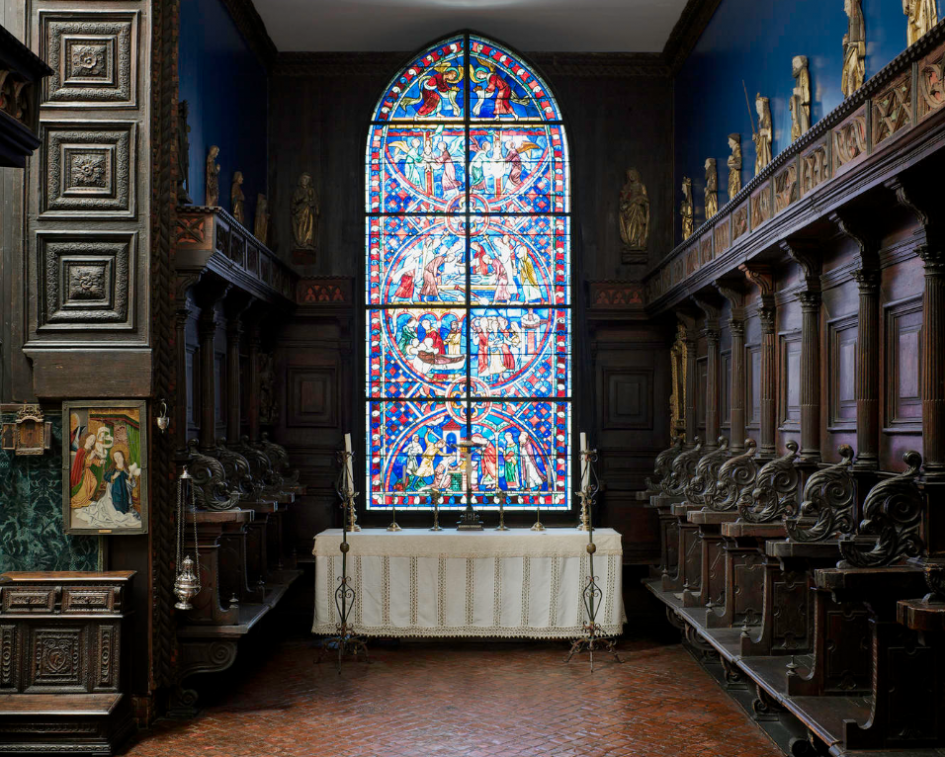
Recent Comments